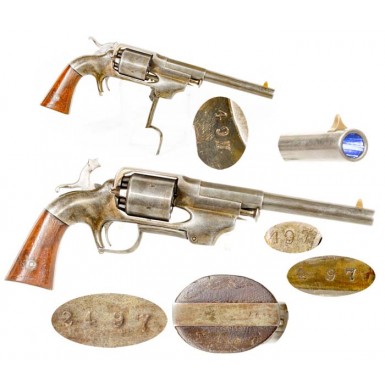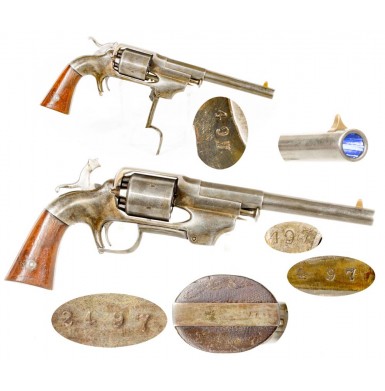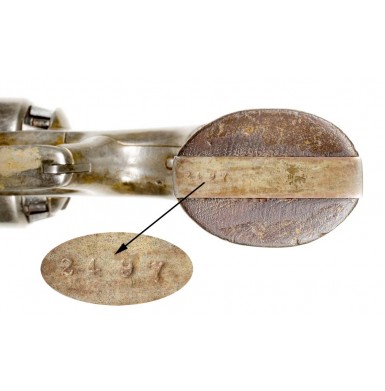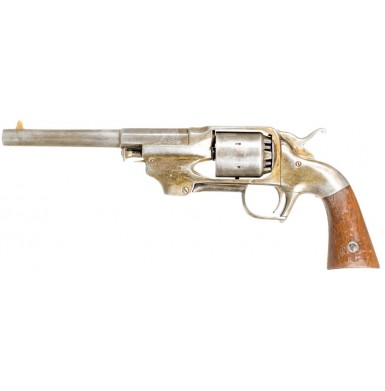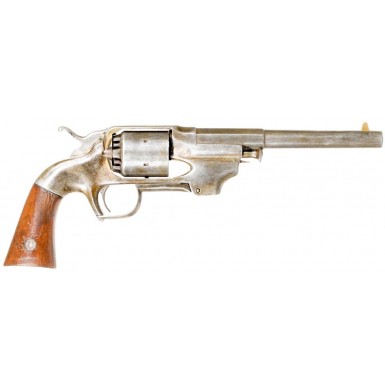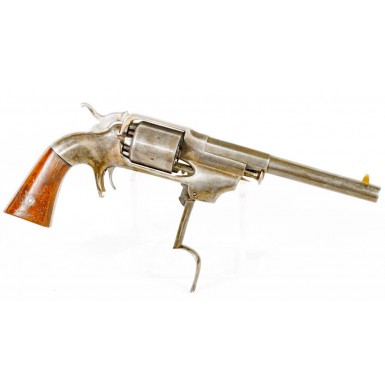Allen & Wheelock Center Hammer Army Revolver
- Product Code: FHG-2068-SOLD
- Availability: Out Of Stock
-
$1.00
The Allen & Wheelock Center Hammer Army percussion revolver (Flayderman 5A-060) was manufactured in rather limited quantities, with production estimated by most published arms historians at only about 700 guns. These estimates are based primarily upon the “serial numbers’ of known surviving examples. However, for a gun with production figures so low, the survival rate of the revolvers appears relatively high, leading some to assume that the “serial numbers’ were relay batch or assembly numbers and do not really indicate total production. In fact, many have long believed that the total production was likely 3 to 4 times the published estimates. The existence of at least a couple of duplicate “serial number” examples certainly supports this theory, and the gun offered for sale here may finally prove that the actual production figures were likely in the 2,500 to 3,000 gun range. No matter how many were actually produced, we do know that 536 were purchased by the Federal government in 1861. Nearly all those guns were subsequently issued to the 2nd & 3rd Michigan Volunteer Cavalry regiments. As these revolvers were purchased on the open market, they were not marked with any US military sub-inspection or final inspection marks (including cartouches), as are found on the guns acquired via official Ordnance Department contracts.
The Allen & Wheelock Army Revolver was a .44 caliber, six-shot, percussion single action revolver that had a 7 ““ half-octagon/half-round barrel and a unique ratcheting loading lever that formed the trigger guard of the revolver. The revolvers had a blued finish with color case hardened hammers and loading levers/triggerguards. The grips were two-piece walnut that were usually varnished but appear to have been oil finished on some extant examples. The guns were made in three distinct variants, which help the collector to categorize and date them chronologically. The earliest guns used a complicated and fragile “hinged pawl” action. This produced a smooth action but was expensive and time consuming to produce and difficult to repair. These guns also had the hammer mounted on the screw that secured the side plate and entered through the right side of the frame. This made disassembly very difficult. The final feature of the 1st variant revolvers was that the cones (nipples) were screwed into the cylinder from the inside of the chambers; a very unconventional feature. The 2nd variant revolvers retained all the mechanical features and designs of the 1st variant but had cones (nipples) that were installed in the conventional fashion, from the rear of the cylinder. The 3rd variant revolvers used a pin that was cast into the right side of the frame to provide a pivot for the hammer to rotate on, with the screw that secured the sideplate entered from the left side of the frame. This made the revolver much easier to disassemble and repair. These guns also utilize a simplified internal action that was cheaper and easier to produce. The guns were normally marked in two lines on the left side of the octagon portion of the barrel with the name, address and patent information about the gun, however, these stampings were often quite light and as a result are usually only partially legible. Since Allen was the ultimate “cheap skate” it was not uncommon for the company to use the same dies to mark different models of guns, even if the die did not quite fit in the space where the markings were to be placed. This resulted in Allen revolvers that often have letters and/or numbers missing from the name and patent information stampings, since the die simply did not fit in the area where it was stamped. It seems fairly certain that the guns were not “serial numbered” per-se but were marked on major parts with assembly numbers. The numbers were usually placed on the left side of the frame (under the grip), on the inner surface of the loading lever, on the rear of the cylinder, on the cylinder arbor pin and inside both wooden grip panels.
The Allen & Wheelock Center Hammer Army offered here is in about VERY GOOD condition. It is a later production, 3rd variant, revolver with the cones (nipples) installed from the rear of the cylinder in the conventional manner and with the simplified lock work that allows the hammer to rotate on the cast frame pin, rather than on the sideplate screw. The most interesting thing about this revolver is that it may actually bear a true serial number, in addition to the usual assembly numbers. The bottom of the grip frame is numbered 2497. Typically, Allen & Wheelock Army revolvers do not have an external serial number like this and the grips must be removed to find the frame number. The other interesting fact is that the last three digits of the serial number are found throughout the revolver like the assembly numbers usually found on the guns. This four-digit number on the bottom of the grip suggests that at least 2,500 or so of these revolvers were really produced. Why Allen did not fully serial number most of the production is unclear, but it seems quite likely that many of the 3rd Variant guns with 3-digit serial numbers may really have had a fourth number that was never applied to them. The three-digit assembly number 497 appears on the expected parts of the gun. The number is found stamped in the usual location on the frame under the left grip, on the top of the cylinder arbor pin, on the rear face of the cylinder, on the inner side of the loading lever (it is sometimes found under the loading lever) and on the interior of both grips; all locations it is typically encountered on these guns. The last number 7 is visible on the bottom portion of the hammer when the sideplate is removed. The gun appears to be 100% complete, correct and original. The gun retains none of its blued finish, a not uncommon condition to find Allen revolvers in. The blue tended to flake very badly on Allen & Wheelock revolvers, so finding one with more than traces of finish is rather difficult. The gun has a mostly smooth, mottled grayish blue and lightly oxidized brownish patina that is no unattractive. Even though the metal appears to have been lightly cleaned it seems to have happened long ago. There are some very small, scattered patches of light surface oxidation present on the revolver, most of which is around the cone recesses at the rear of the cylinder. There is also a little bit of very minor pinpricking scattered here and there. The bore of the revolver rates about FINE and is mostly bright and clean, with crisp rifling and only some very minor scattered frosting in the grooves, along with some lightly scattered pitting. Normally the guns are marked in two lines, on the left octagon barrel flat: ALLEN & WHEELOCK . WORCHESTER, MASS. U.S. / ALLEN’s PT’s . JAN . 13 . DEC . 15 . 1857 . SEPT. 7, 1858. This gun does not bear this marking, nor does it appear to have been cleaned or polished off. Allen & Wheelock markings are notoriously light, but there is absolutely no indication that this revolver was ever marked. The odd high serial number and lack of markings suggest that maybe the gun was assembled at the very end of production, or possibly during the 1864-1865 period after the death of Thomas Wheelock when Ethan Allen was reorganizing the company as E Allen & Co. The pistol functions extremely well and remains mechanically excellent. It times, indexes and locks up perfectly. The cylinder rotates when the hammer is cocked and the trigger functions as it should. The half-cock notch also works correctly, freeing the cylinder to rotate. The loading lever functions correctly and smoothly and operates exactly as it should. All of the six cones (nipples) are original and they are in very good, crisp and usable condition as well. As noted, the cone recesses show some light pitting and corrosion as would be expected from the erosive percussion cap flash wear that is present on a percussion revolver that saw actual use. The walnut grips rate about VERY GOOD to NEAR FINE overall. The grips retain 30%+ of their original varnished finish. As would be expected from any secondary martial revolver that saw any level of use, the grips show the usual scattered bumps and dings from handling and use. The grips, however, remain solid and show no cracks, breaks or repairs.
Overall this is really solid example of a late production Allen & Wheelock Center Hammer Army percussion revolver. The gun is in nice, complete condition, and displays very well. The interesting four-digit serial number on the bottom of the grip frame may help shed some light on the actual numbers of these guns produced. This revolver may be that missing link that helps to unlock some of the mysteries of Allen & Wheelock percussion revolvers from the Civil War era.
SOLD
